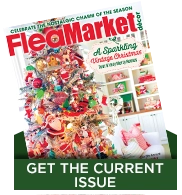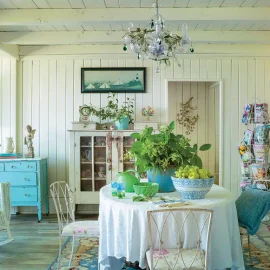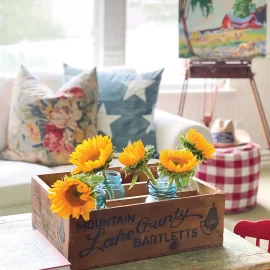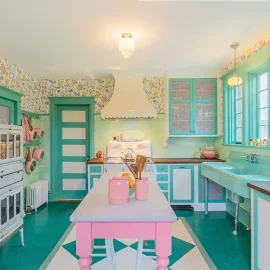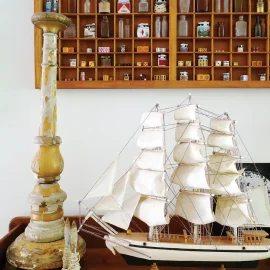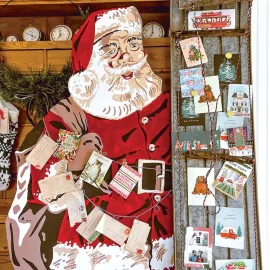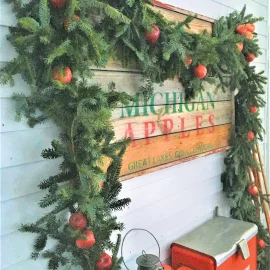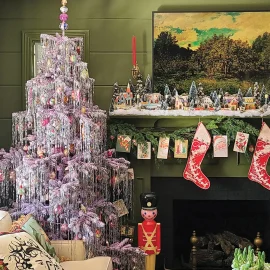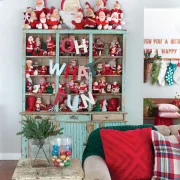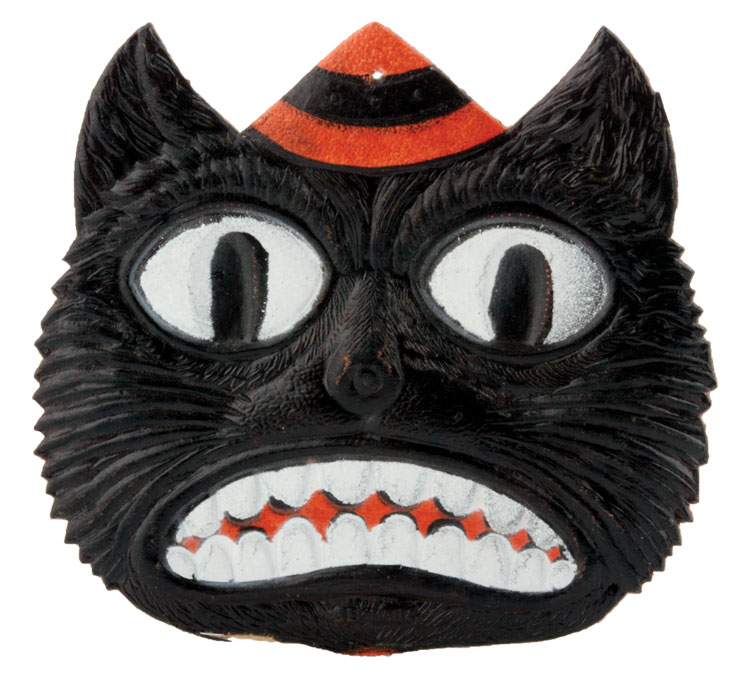
All Hallow’s Eve never ends at the northern California home of Mark Ledenbach. The renowned expert on Halloween collectibles keeps his remarkable treasures on display year round. “I admire and envy people who put them out once a year,” he says.

But his collection is large enough that if he took it down, “my walls and cabinets would be denuded,” he says. Known as the “Dean of Halloween,” Mark is the author of Vintage Halloween Collectibles, now in its third edition. You may have even seen him chatting up Martha Stewart on her TV show.

Mark started his Halloween collection in 1988, and has seen the “sport” grow. “As with Christmas collectibles, the market is robust,” says Mark. Yet Halloween mementos are rarer. “Christmas decorations tended to be boxed up and saved from year to year,” he says, “but if you gave a Halloween party in the 1920s, would you have saved the invitations?” That rarity, combined with the interest, has led to a hot market.

Mark saw a flawless single party invitation recently sell for $227. “As a flea-market goer, you hope that someone is setting up and letting Halloween stuff go for a song … Flea markets are wonderful places for discovery,” he says. On a recent flea-market hunt, he found several items worth $70 and paid $7 for each.

The bulk of Mark’s collection is from the late 1910s and 1920s, which correlates with when Halloween took off in America. It’s hard to believe today, but this holiday wasn’t originally for children. It was for grownup partygoers— that’s why the collectibles are things like fortune holders and place cards that feature scary graphics. “Then in the 1930s, depending on where you were in the U.S. (we think in the Midwest), trick or treating started. After World War II, kids confiscated the holiday,” says Mark, and party goods became more smiley. But Mark prefers the sinister stuff.

Fakes Invade Market
Now speaking of scary, there are some unscrupulous vendors who take advantage of the popularity of Halloween collectibles by selling fake vintage pieces. Mark can trace this insidious problem back to about 1995. “They were all brought in by one person, who represented a number of factories,” he notes.

There are certainly many nice, vintage-inspired Halloween décor items, and that’s fine. What makes it nefarious is when people make money by passing new things off as old. “I’m protective of the hobby,” says Mark. “I don’t want people who are new to it to get ripped off, just morally. Also because I want a market for my own collectibles (he sells online on his website), I don’t want them to get discouraged by these hucksters and get out of the market.”

There are two types of fakes. Reproductions are based on true designs from history that someone has tried to replicate. A fantasy piece, on the other hand, never existed in the 1920s and 1930s; there’s no known counterpart. Mark uses a well-known example: a devil blowhorn. It was such a good counterfeit that, unfortunately, it made it into another reference book.

How to Safely Display Halloween Collectibles
It’s all about climate control. “I don’t let the temperature go above 80°F or below 60°F in my home. That range is safe for most paper,” says Mark. “If you have the ability to keep things out year round—and a lot of collectors don’t want to do that—make sure the composition pieces are in a case,” says Mark. “And keep the lights off as much as possible, as light is cumulatively damaging.”

Mark hangs die cuts on the wall, as that is how they were meant to be used. (A die cut is a piece of cardboard used as decoration.) If there is no hole in the die cut, don’t create one. Just mount it by bracing it with a clear-ended pushpin so you don’t detract from the design.

One of Mark’s cherished finds was a circa 1930s Beistle die cut of a skeleton walking through a graveyard. “There are only maybe 10 in existence,” says Mark. “They go for astronomical sums. One sold for $3,600.” This is for a piece of cardboard!


The earliest piece in Mark’s collection is from 1891. It’s a devil smoke set—an ashtray, humidor and match striker—that advertised liquor and sat on a plate. It wasn’t made for Halloween but is sought after by Halloween collectors because of its theme and excellent porcelain.


Mark sees people of all ages getting into Halloween collecting. Many people get intrigued after throwing or attending a party. Perhaps the holiday itself is being reclaimed as the spooky adult pastime it once was. “I have seen more movement in this hobby in terms of new entrants in the past five years than I did in all of the past 30,” says Mark. “It’s just nuts … in a let’s-keep-it-going really fun way.”

How to Spot a Fake
CHECK THE PRICE. “The dealers that want to make a quick buck will sell things at prices that are much too low,” says Mark. “They’ll price something that would be worth, say, $200 at $84.99.”
TAKE A FEEL. With composition pieces, the new pieces are made with polymers that repel heat. So they are often cold or cool to the touch, while vintage pieces are not.

ASSUME THEY ARE REPRODUCTIONS. With paper inserts, which cover the mouth and nose of 1940s and 1950s lanterns, always assume they are reproductions, until proven otherwise. Even Mark has to examine these in person to tell the difference.
LEARN. In addition to Mark’s book, he recommends Halloween Collectibles: A Price Guide by Dan and Pauline Campanelli and Halloween in America: A Collector’s Guide with Prices by Stuart Schneider. Also network and go to every show you can.

BE SKEPTICAL. The scam goes like this: “Since the Berlin Wall fell, gosh, all this vintage Halloween merchandise was discovered in a factory,” says Mark. The Germans didn’t celebrate Halloween after World War I and had no reason to retain Halloween goods in their factories. “They were making things for the American market, places like Woolworth,” says Mark. Walk away from claims of “only a pair to sell” or “recently found.”

Halloween Imagery: THE PYRAMID
CHECK FOR REISSUES. Beistle Company of Shippensburg, Pennsylvania, made many of the original items. “They have started to reissue some of the iconic designs, but in a way that respects the secondary market,” Mark says. “The sizes and colors are different from the originals, and the new products have the original release as well as the current date.”

Most often you’ll see pumpkins and jack-o’-lanterns. They are the most common and make up the base of the pyramid, as Mark calls it. “Then come black cats; then it gets a little squishy. Witches and a mishmash of ghosts, owls, bats and, at the top, devils.” Some collectors prefer not to have devils in their collections. Other occasional imagery includes ravens, crows and ghouls.

